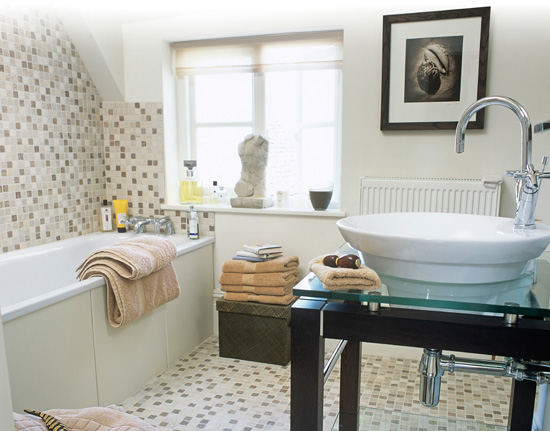
The bathroom is the perfect place to relax at both the beginning and end of the day, so it is worth spending a little time creating a serene, spa-like feel. A few small changes are often all it takes to add a comforting ambience even to an older bathroom.
New mirrors and lighting can help freshen up a tired-looking bathroom, and changing the fabrics, towels and tiles sets a new tone. But ventilation and hygiene should remain a top priority as mildew will damage the room’s appearance and can be harmful to health.
• Use a softer bulb as dim lights can help create the right ambience for a relaxing bath. Also, artfully placed candles can add to the spa feel and provide flattering lighting for almost any skin type.
• Use light colors such as white, pale blue and beige or light-colored wood to make smaller bathrooms appear larger. If you can’t replace tiles or repaint the room, choose accessories in lighter shades.
• Install a new shower partition. This can be done without much trouble and it works wonders, especially in older bathrooms.
• Clear out the clutter: The only things on display should be those in daily use.
• Store towels in a bathroom cupboard if space is limited. Or, for a chic yet practical solution, roll them up, secure each with a ribbon and place them standing up in a basket by the bath.
• A larger bathroom is ideal for exotic, humidity-loving bonsai trees and tropical plants.
• Add suitably upholstered furniture to create a stylish, inviting place to relax. Stools with terry cloth seats are practical and provide comfortable seating while you paint toenails or moisturize skin.
• Bring in soothing scents such as lavender, orange and vanilla in the form of aromatherapy candles, lotions or scent diffusers.
• Keep a waterproof clock in the bathroom—one that can be attached to the tiles with suction cups is perfect—so you can keep an eye on the time while getting ready.
• Get a waterproof radio if you like to start the day with music.
MODERN fabrics and fixtures HARMONIZE WITH OLDER TILES.
Well-chosen fabrics can turn the bathroom into a comfortable, attractive space. They should also be kind to skin.
• Choose a shower curtain that complements the rest of the bathroom furnishings. Waterproof fabric curtains are more chic and attractive than plastic ones but need regular cleaning, so make sure they are machine washable.
• Opt for matching towels in different sizes to give the bathroom a coordinated look. Thick, high-quality towels will make drying off after a bath an absolute joy and will last for years.
If old, cracked tiles, graying grout or 1970s decor are cramping your style, don’t begin demolition work immediately. Take a cue from earlier generations and fix rather than discard.
• Try thoroughly cleaning the existing tiles, which injects new life at once. For stubborn stains, use water mixed with ammonia or alcohol, and remove scale with vinegar. Rub old tiles with a little linseed oil to make them shine again.
• Repair small cracks in the tiles with matching paint from an art supply store. Mix a small amount of the paint with grout and apply to the tiles to fill hairline cracks. Rub smooth.
• Refresh older tiles by repainting the grout (special grout-coloring kits are available). But remember that grout paint can’t be used on nonenamel tiles or on top of water-resistant joint sealer.
• Visually enlarge the bathroom with adhesive mirror tiles. They are a good choice when replacements for old tiles are no longer available. Or paint over unwanted tiles with tile primer and lacquer to cover them.
• One simple but effective solution is to apply a new layer of tiles over unsalvageable existing ones. This is cheaper and easier than removing the old layer and resurfacing the wall.
• Even easier is to paint over tiles with tile paint—but only if tiles aren’t going to get wet regularly.
Replacing damaged tiles
Damaged tiles can cause bigger problems in a damp environment. If you discover a cracked or chipped tile, follow these simple steps as soon as possible to limit the damage. If you can’t match tiles exactly, use contrasting replacements.
one Remove the grout around the damaged tile and use a dry-cut saw drill attachment to slice diagonally through the tile, or make several holes with a drill.
two Chip off fragments of the tile with a hammer and flat chisel until the whole thing comes loose. Remove as much of the old adhesive as possible.
three Cover the back of the replacement tile with bonding material and press it onto the wall, using tile spacers to position and fit it correctly.
four Let the glue dry overnight (or as directed by the manufacturer). Then apply grout and clean.
The best remedy for mildew is good air circulation, which gets rid of moisture so mildew can’t take hold. Turning on the bathroom fan is the first step, but try some of these tips, too.
• Wipe condensation from the shower wall and tiles with a squeegee after each shower.
• Use vinegar to clean the corners between the shower or bath and the tiled wall regularly.
• Paint untiled wall surfaces and the ceiling with a mildew-resistant paint.
• Remove the grout where mildew has taken hold, clean thoroughly and seal the cleaned edges with new grout.